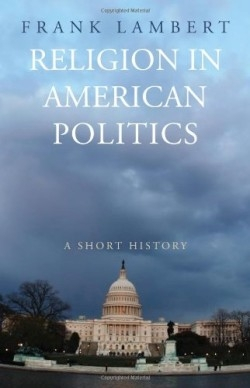Religion in American Politics
A Short History
In America at least, the old joke warns friends never to discuss religion or politics over drinks or dinner lest their conversation turn them into mortal enemies. Ever since the Founding Fathers included a clause in the Constitution regulating the relationship between church and state, religious people have struggled with the extent to which they can enter into politics, and political pundits have often shied far away from any expression of religious faith or belief. Yet, in this election year the presidential candidates have often showcased their religious beliefs in order to woo voters who believe that religion plays a crucial role in shaping political decisions.
As Frank Lambert, professor of history at Purdue University and author of The Founding Fathers and the Place of Religion in America points out in his brilliant new book, the contentious relationship between religion and politics has been a feature of the American landscape since William Bradford declared the Massachusetts Bay Colony as the New Jerusalem, the “City Upon a Hill,” firmly situating the New World as a part of God’s plan for the salvation of the world. By the dawn of the new republic however, the religious unity of America was more and more challenged by leaders who ignored religion in discussions concerning the governance and formation of the young nation. In 1774, for example, New York minister Samuel Sherwood considered America to be the New Israel and proclaimed that its civic leaders should adhere to God’s laws. A short thirteen years later in 1787, delegates to the Constitutional Convention in Philadelphia, fearing sectarian strife, left religion out of discussions regarding the emerging political documents of the new republic. As Lambert points out so eloquently, the seeds of the strife between religion and politics that have blossomed in American society over the past fifty years were planted in 1776.
In this magisterial survey of the role of religion in politics, Lambert examines several moments in American history—the sectional division of the States over slavery, the conflict between Andrew Carnegie’s “Gospel of Wealth” and Walter Rauschenbusch’s “Social Gospel,” Fundamentalism’s debates with Modernism, the Civil Rights Movement, and the rise of the Religious Right and the Religious Left, among others—in which religious movements attempted to shape political movements.
By focusing on these historical moments, Lambert illustrates his two theses. First, “religious coalitions seek by political means what the Constitution prohibits, namely, a national religious establishment, or, more specifically, a Christian establishment. Religious groups become politically active because of their dissatisfaction with prevailing public policy.” The earliest attempts at reforming and reviving the religious character of the republic occurred in the early nineteenth century. Evangelicals sought to revive and transform the hearts of individuals through spiritual awakenings, or revivals. More important, evangelicals organized a number of benevolent societies—such as the American Temperance Union (1826) and the American Prison Discipline Society (1825)—aimed at the moral reform of society. In the late nineteenth and early twentieth centuries, groups as diverse as the Civil Rights movement, the Moral Majority, and the Social Gospel movement all arose out of churches as attempts to address failed public policy.
Yet, no single religious group can speak for all the others. According to Lambert’s second thesis,“ any religious group’s attempt to represent the nation’s religious heritage or claim to be its moral conscience is sure to be met with opposition from other religious groups as well as nonreligious parties.“ In 1828, when the government established mail service on Sunday, the Baptists and Methodist opposed the regulation on the grounds that it violated the Fourth Commandment, to keep God’s Day holy and as a day of rest. Seventh Day Baptists and Universalists disagreed, however, contending that Sunday was not a holy day for all Christians. The sectarian character of American religion became even more evident in the “rift between modernists and fundamentalists” in the early twentieth century that revealed “long-standing disputes over such basic questions as the relation between faith and reason, the nature and interpretation of the Bible, the church’s stance toward secular society, and the question of morality and history.”
In this election season, with candidates often touting their plans to include religion in their political platforms, Lambert’s richly-textured book provides a timely reminder of the divisiveness of religion and the wisdom of the Founding Fathers in keeping it out of national politics.
Reviewed by
Henry L. Carrigan
Disclosure: This article is not an endorsement, but a review. The publisher of this book provided free copies of the book to have their book reviewed by a professional reviewer. No fee was paid by the publisher for this review. Foreword Reviews only recommends books that we love. Foreword Magazine, Inc. is disclosing this in accordance with the Federal Trade Commission’s 16 CFR, Part 255.

